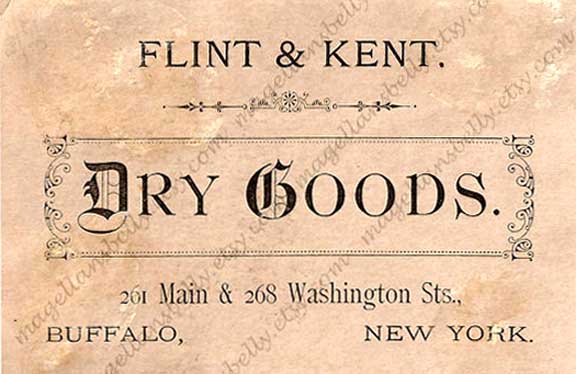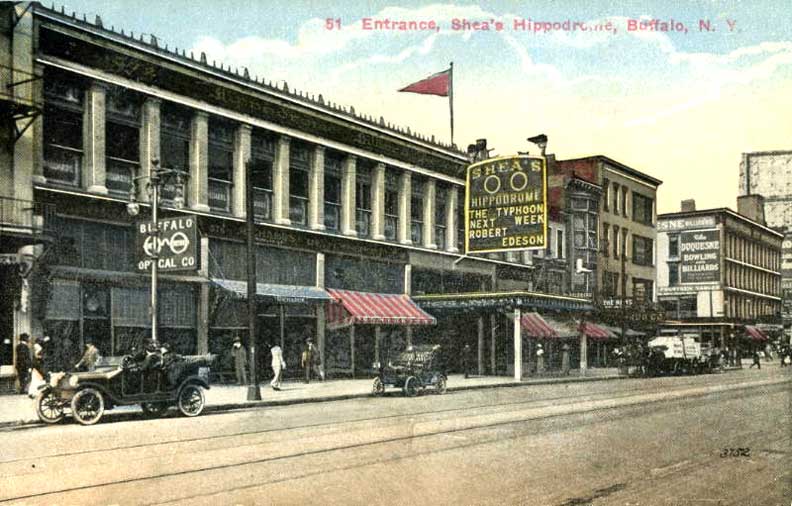Flint & Kent Dry Goods /Hippodrome Theater
On the 2016 Fountain Plaza site
Excerpts from Buffalo Place Fountain Plaza History
(online June 2016)
Flint & Kent  Map courtesy of Joseph Bieron and Paul McCarthy, Postcard Views: A Walk Down Main Street Bufflo, New York, circa 1910, Buffalo Beritage Unlimited, 2007  |
|
The Flint & Kent store began when Benjamin Fitch opened a dry goods store in 1832. This small business was located at 288 Main Street. As time went on, Fitch decided it was time to let the business grow. He wanted to invite partners to join the company. In 1836, the store was called Fitch, Marvin and Company. In 1856 William B. Flint joined the company. Then in 1865 Henry M. Kent joined the ever growing company. By the time Kent joined the business Benjamin Fitch had retired. This meant the store was now called Flint, Kent, & Stone. Stone would later sell to Howard. This last partner did not last long due to illness and he sold his shares to the remaining owners, Flint and Kent. The company became known as Flint & Kent and was located at 261 Main Street. Flint and Kent began to grow rapidly. They
outgrew their headquarters on 261 Main Street and began planning to
build a bigger store at 554 Main St in 1897. This was the
location of the old Universalist Church for the Messiah which was built
in 1866, caught fire in 1870 and was rebuilt, and the congregation
relocated to a new church building in 1892. The Universalist Church
leased the structure to the bike company H.C. Martin & Co in 1894.
Flint and Kent decided the location of the church would make the
perfect spot for the new headquarters. They tore down the church and
enlisted one of Buffalo’s top architects to design the new store.
The accomplished architect was Kent’s own son, Edward Kent. He designed many prominent buildings in Buffalo. Some of his works include the Otto Store, which became the Theatre Place Building; the original Temple Beth Zion, Unitarian Universalist Church and many residences throughout the city. Edward Kent was also known for forming the Buffalo Society of Architects. This was the first of its kind in the city. Sadly, Edward Kent met his demise after a two month holiday abroad. Edward Kent was making his way home on the Titanic and he was not one of the lucky ones to survive the sinking. The original success of Flint & Kent was in the dry goods business but this changed as the company grew in recognition. The store became known for “ready-to-wear clothing for all occasions.” The year 1932 proved to be a big year for Flint & Kent. Their headquarters had four floors of merchandise. They also had over 46 branch department stores, all larger than the original store. The year 1932 was also the 100th anniversary since the company began. Lastly, 1932 was the year Flint and Kent sold the business to Charles Jack Hann, whose father owned Sattler’s. Winthrop Kent remained as the store manager after the purchase. No major changes were made to company operations. The store appearance was updated to appear more modern. Hann sold the store in 1956 to the upscale clothing store, Sample Inc., but they occupied the store only until 1959. Sample Inc. sold to Huron Stores Inc. which went bankrupt after a short time. The downtown store was closed and sold in 1964. In 1965 the first floor was leased out to William T. Grant so his store could expand their downtown location. The building which housed Flint & Kent was knocked down to create Fountain Plaza. |
The Hippodrome  Postcard |
|
The Hippodrome
The Hippodrome Theater was the first movie house in the city of Buffalo, part of the theater chain owned by Michael Shea. The Hippodrome was designed by Leon H. Lempert Jr., opening in 1914. The Hippodrome, named for the ancient Greek stadiums used for horse and chariot races, entertained the people of Buffalo just as its namesake entertained the ancient Greeks. The Hippodrome had a 2,800 seat capacity with one movie screen. In 1951 the Hippodrome was renamed Center Theatre and was renovated by new owner, Michael J. DeAngelis. Suburban theaters were becoming more competitive and DeAngelis wanted the Hippodrome to have a modern look. The original marquee was taken down and replaced. The foyer was also updated. In the 1960s, Center Theatre had rights to almost all Warner Brothers/Seven Arts/Hammer Films movies. Regardless, Center Theatre closed down in 1962. The building itself was demolished in 1983 for construction of Fountain Plaza. |
Page created in 2016 by Chuck LaChiusa
| ...Home Page ...| ..Buffalo Architecture Index...| ..Buffalo History Index... .|....E-Mail ...| ..

web site consulting by ingenious, inc.
